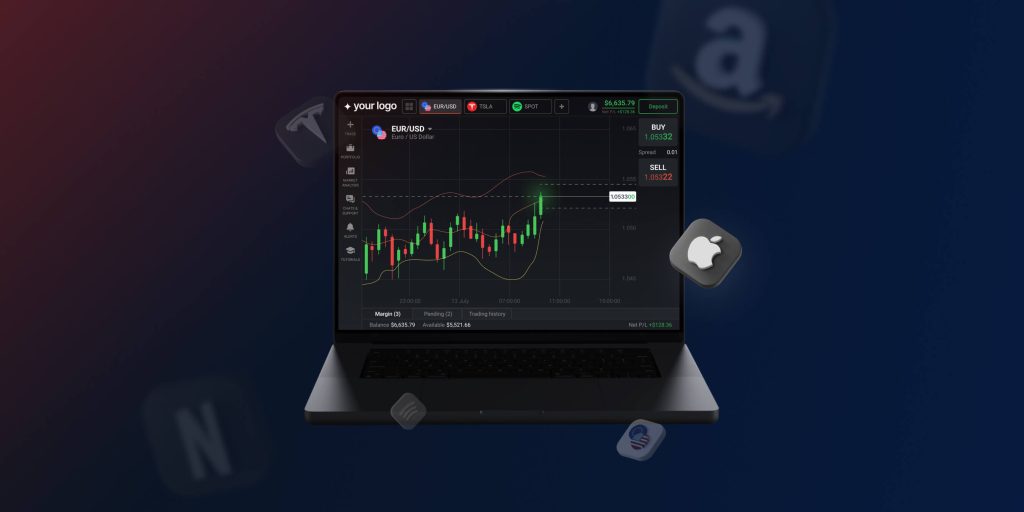
Top 10 Clases de Activos de Trading Populares para 2026
Contenidos
Las mejores clases de activos para operar en 2026 están impulsadas por dos temas clave: la monetización de la Inteligencia Artificial y un mandato generalizado de los inversores para diversificarse lejos de las acciones de mega-cap de EE. UU. más concentradas. Esto se expresa en un aumento del volumen de operaciones en sectores infundidos con IA, crédito de alto rendimiento, activos alternativos y mercados internacionales de buen rendimiento.
Algunas de estas clases de activos tuvieron un rendimiento muy bueno a lo largo de 2024 hasta 2025, y están manteniendo ese impulso hacia 2026. Entender cuáles clases de activos tienen el mayor potencial en un clima tan agitado puede impactar significativamente tu éxito en el trading. Además, diversificarse en múltiples clases de activos reduce el riesgo mientras se obtienen los máximos retornos potenciales en un entorno económico cada vez más complejo.
Las 10 clases de activos de trading más populares para 2026 son:
- Cadena de Valor de IA y Acciones Tecnológicas
- Renta Fija (Bonos Corporativos de Alto Rendimiento)
- Criptomonedas (Adopción Institucional & Integración de IA)
- Acciones Internacionales (Japón y Europa)
- Fondos Cotizados en Bolsa (ETFs) (Granularidad Temática)
- Acciones de Valor y de Pequeña Capitalización de EE. UU.
- Acciones de Energía e Infraestructura Energética
- Oro, Plata y Metales Estratégicos
- Bonos del Tesoro a Corto Plazo & Alternativas de Efectivo
- Fideicomisos de Inversión en Bienes Raíces (REITs) y Activos de Infraestructura
Profundicemos más en cada clase de activo y también consideremos algunos candidatos prometedores en cada clase.
Cadena de Valor de IA y Acciones de Tecnología
La tesis de 2026 ha pasado de la exageración de la IA a la monetización de la IA. El comercio ahora se concentra en empresas con productos y servicios tangibles, generando ingresos monumentales y realizados a partir de la implementación de la IA. Se proyecta que el tamaño del mercado global de IA alcanzará los $2 billones en 2026, desde $757 mil millones en 2026. Ciertos segmentos están expandiéndose a un Tasa de Crecimiento Anual Compuesta (CAGR) del 19.20% durante la próxima década.
Las principales acciones de IA para 2026 incluyen:
- Fabricantes de Semiconductores & Memoria impulsando la infraestructura de IA (La capa de hardware ineludible).
- Empresas de Computación en la Nube que impulsan cargas de trabajo de IA (La capa de infraestructura ineludible).
- Empresas de software que demuestran ingresos de alto margen provenientes de aplicaciones de IA empresarial (La capa de aplicación).
- Especialistas en robótica y automatización.
Por qué las acciones de IA todavía lideran el comercio de 2026:
- Gran Acumulación de Ingresos: Las empresas están reportando aumentos de ingresos enormes y verificados de servicios y productos relacionados con la IA, superando con creces las expectativas.
- Aumento de la adopción de IA en empresas: Se ha superado el punto de inflexión para la adopción de IA en los negocios, lo que impulsa una demanda sostenida. Más del 80% de las empresas ahora implementan IA en sus operaciones centrales, según McKinsey, alimentando una demanda sostenida en toda la cadena.
- Financiamiento y apoyo gubernamental para la infraestructura de IA doméstica.
Hubo poco beneficio para muchos traders que persiguieron empresas de capa de aplicación en 2024-2025. En comparación con índices tecnológicos más generales, aquellos que se concentraron en jugadores fundamentales, especialmente en semiconductores e infraestructura de nube, frecuentemente experimentaron un rendimiento superior del 30% o más. En 2026, esta distinción seguirá siendo crucial.
Renta Fija
En 2026, el mercado global de bonos entrará en una nueva fase que se caracterizará por una inflación más lenta, tasas de política estabilizadas y un renovado apetito por rendimientos tras tres años de un agresivo endurecimiento monetario. Durante los próximos 12 meses, se predice que la Reserva Federal bajará las tasas de interés, y el Banco Central Europeo y el Banco de Inglaterra seguirán el mismo camino, aunque más lentamente. Este cambio está creando uno de los puntos de entrada más atractivos para los inversores en renta fija en más de diez años.
Por qué la atención está regresando a los bonos
Los bonos sufrieron durante la mayor parte de 2024-2025 debido a las altas tasas de interés y la inflación inestable. Sin embargo, 2026 parece ser diferente. Se espera que los precios de los bonos aumenten, y los rendimientos siguen siendo históricamente altos en comparación con el período ultra-bajo de la década de 2010, ya que se prevé que la inflación global se acerque a 2.4% a 3.0% y los bancos centrales se están preparando para flexibilizar.
Aquí están los principales segmentos del mercado de bonos para el Trader 2026:
- Bonos Corporativos de Alto Rendimiento (El Enfoque de Ingresos): Con rendimientos en el rango del 6.5%-7% en mercados desarrollados, los márgenes de crédito siguen siendo atractivos en comparación con los promedios históricos.
- Bonos corporativos para rendimiento de calidad.
- Bonos Municipales por ventajas fiscales.
- Valores del Tesoro para exposición a refugios seguros y estabilidad de la cartera.
Beneficios del Comercio de Bonos:
- Flujos de ingreso esperados: Asegurando cupones atractivos antes de posibles reducciones de tasas.
- Reducción del Riesgo de Volatilidad de Precios: La estabilización de tarifas reduce el riesgo de fuertes caídas de precios observadas durante el ciclo de aumentos.
- Oportunidades de protección contra la inflación y estabilidad en el portafolio.
- Menos volatilidad que las acciones.
También te puede gustar

Considere el riesgo de tasa de interés y el riesgo de crédito cuando compre y venda bonos. El aumento de las tasas afectará los precios de los bonos, particularmente en los valores a más largo plazo.
Criptomonedas
Las criptomonedas siguen a la vanguardia de la innovación en el comercio, pero el catalizador para la popularidad en 2025 está en la legitimación institucional, el enfoque en los tokens relacionados con la IA y el crecimiento explosivo de los activos del mundo real tokenizados (RWAs).
Este aflujo no solo ha solidificado el papel de Bitcoin como un de facto activo institucional, sino que también ha mejorado significativamente la profundidad y liquidez del mercado.
Tendencias Principales de las Criptomonedas para 2026
- Adopción Institucional: A raíz de la aprobación de ETF de Bitcoin y Ethereum al contado, la adopción institucional está ganando impulso, mejorando la liquidez y estabilidad del mercado.
- Criptomonedas Integradas con IA: Las criptomonedas relacionadas con la IA, vinculadas a la IA descentralizada, la verificación de datos y el aprendizaje automático, están aumentando rápidamente.
- La tokenización de activos está ampliando las oportunidades del mercado.
- Bitcoin y Ethereum siguen siendo los líderes del mercado como los activos institucionales subyacentes.
El crecimiento de las estrategias de rendimiento en cadena es otro cambio significativo en 2026. Con rendimientos que a menudo igualan o superan los de los mercados tradicionales, los inversores están buscando cada vez más el staking, el lending y los productos de renta fija tokenizados para obtener ingresos. Esto, junto con una infraestructura de mercado mejorada y una liquidez más profunda, hace que el ecosistema de criptomonedas sea menos especulativo y más atractivo de lo que era en ciclos anteriores.
Ventajas del Trading:
- Accesibilidad a los mercados 24/7.
- La alta volatilidad ofrece oportunidades de ganancia.
- El aumento del apoyo institucional ha mejorado la infraestructura del mercado y la liquidez.
- Bajar las barreras de entrada en comparación con los mercados tradicionales.
Recuerda que los mercados de criptomonedas son extremadamente volátiles. Por lo tanto, se deben adoptar estrategias de gestión de riesgos efectivas al comerciar con monedas digitales.También puedes consultar nuestra guía sobre cómo comerciar con criptomonedas para más información.
Acciones Internacionales
Aunque los índices de acciones de EE. UU. siguen estando altamente concentrados y caros, los traders están buscando activamente diversificación hacia mercados globales con un mejor valor relativo y vientos a favor estructurales.
Un cambio geopolítico y macroeconómico también está impulsando la tendencia: a medida que las disputas comerciales y los aranceles remodelan las cadenas de suministro globales, el capital se está moviendo hacia regiones como India, el sudeste asiático y partes de América Latina que se posicionan como alternativas a las dependencias entre EE. UU. y China. El reshoring, el crecimiento de la población y una demanda interna robusta están ayudando a estas regiones.
Áreas de Enfoque Internacional 2026:
- Japón: Impulsado por reformas de gobernanza corporativa a largo plazo y el resurgimiento de la inflación.
- Europa: Ofreciendo un fuerte potencial de rebote cíclico y valoraciones más atractivas que las de EE.UU.
- India y ASEAN: Actualmente liderando los flujos de capital de renta variable global debido a su rápido crecimiento del PIB, expansión de la manufactura y mercados de consumo en expansión.
- América Latina: La demanda de minerales vitales y materiales para la transición energética está ayudando a economías ricas en materias primas como Brasil y Chile.
Ventajas del Trading:
- Valor relativo: Valoraciones más atractivas en relación con las mega-caps de EE. UU.
- Exposición a ciclos económicos no estadounidenses.
- Ventajas de la diversificación de la cartera.
- Vientos a favor demográficos y estructurales en mercados focalizados (por ejemplo, la reforma en Japón).
Sin embargo, la inestabilidad política, la exposición a la moneda y los cambios regulatorios pueden impactar significativamente las inversiones globales. Por lo tanto, se aconseja la diversificación geográfica e industrial en consonancia.
Fondos Cotizados en Bolsa (ETFs)
Los ETFs están ganando popularidad, con la industria global de ETFs que se espera alcance USD $20 billones en AUM para finales de año. El enfoque ahora está en la granularidad temática, utilizando ETFs para acceder a una exposición específica a tendencias concretas y cubrir el riesgo de concentración en acciones individuales.
El aumento en los ETFs gestionados activamente y los ETFs de buffer, que combinan gestión experta con liquidez intradía, es un desarrollo notable este año. En un clima macroeconómico impredecible, estos productos están atrayendo tanto a traders institucionales como minoristas que buscan una mejor protección a la baja y mayores rendimientos ajustados al riesgo.
Principales temas de ETF para 2025:
- ETFs temáticos: Enfocándose en temas de alto crecimiento como Ciberseguridad, Innovación en Longevidad/Sanidad y Infraestructura Energética de Nueva Generación.
- ETFs específicos del sector que se centran en sectores de menor valoración y potencial de rebote (por ejemplo, Industriales, Financieros).
- ETFs internacionales para la diversificación geográfica.
- ETFs Internacionales y Multiactivos: Utilizados para diversificar la concentración en EE.UU.
- ETFs de materias primas y bonos para inversiones en recursos y renta fija.
La rápida incorporación de estrategias centradas en ESG y clima en productos de ETF es otro desarrollo notable en 2026. Aunque ESG enfrentó desafíos en el pasado, las crecientes demandas regulatorias y los objetivos globales de descarbonización han reavivado el interés en los ETF que se centran en carteras de energía limpia, baja en carbono e infraestructura sostenible, especialmente en Europa y Asia.
Ventajas de los ETFs:
- Diversificación instantánea dentro de un tema o sector seleccionado.
- Costos más bajos que los fondos mutuos.
- Flexibilidad en el comercio intradía.
- Participaciones transparentes.
Pero compara las tenencias subyacentes y las relaciones de gastos antes de invertir. Algunos ETFs de nicho podrían tener mayores costos o problemas de liquidez.
La expansión de los ETFs negociados 24/5, o productos que se negocian fuera del horario regular del mercado, también está aumentando la liquidez y permitiendo a los traders responder más rápidamente a los anuncios de ganancias y eventos macroeconómicos.Puedes consultar nuestras mejores estrategias de trading de ETFs para obtener más información sobre cómo capitalizar las fluctuaciones de precios.
Acciones de Valor y de Pequeña Capitalización en EE. UU.
A medida que el mercado de EE. UU. en general está lidiando con el enfoque del rendimiento en unas pocas mega-capitalizaciones, 2026 está siendo testigo de una renovada rotación hacia los segmentos de valor y de pequeña capitalización.
La ola de reubicación en EE. UU., que está siendo impulsada por la diversificación de la cadena de suministro, el gasto en infraestructura y la política industrial, es un motor significativo este año. Está trayendo nuevas inversiones en industrias como la manufactura, la logística y la infraestructura energética.
Principales impulsores de valor y pequeñas capitalizaciones en EE. UU.:
- Mercado en Crecimiento: Capital que migra de acciones de crecimiento de mega-cap caras hacia áreas de valor que están fuera del radar.
- Entorno de tasas favorables: Las empresas más pequeñas, al ser más sensibles a las tasas, pueden beneficiarse enormemente de la aplanamiento de las tasas.
- Valoraciones Atractivas: Se comercia a descuentos de valoración de varios años en comparación con los grandes índices.
- M&A Momentum: Las valoraciones más bajas y el reposicionamiento estratégico están impulsando un resurgimiento en las fusiones y adquisiciones de pequeñas empresas.
Estas acciones tenderán a ser más volátiles que las del universo de gran capitalización. Un análisis fundamental completo es esencial si deseas aprovechar al máximo la oportunidad disponible.
Acciones de Energía e Infraestructura Energética
Los mercados de materias primas están impulsados por una historia de demanda bidireccional en 2025: el riesgo geopolítico inclinándose a favor de los mercados de materias primas está impulsado por una historia de demanda bidireccional en 2026: el riesgo geopolítico inclinándose a favor de la energía antigua, y el auge de la IA impulsando una nueva demanda de infraestructura energética. Los futuros del crudo Brent promediaron aproximadamente USD $66/barrel en 2025, apoyando los ingresos del sector energético hasta 2026.
Sectores Clave de Materias Primas y Energía
- Infraestructura Energética y Servicios Públicos: Una demanda masiva de electricidad (un crecimiento de 5 a 7 veces en 3 a 5 años) por parte de los centros de datos impulsa el comercio y la inversión en redes eléctricas y servicios públicos.
- Commodities Energéticos (Petróleo & Gas Natural): Las dislocaciones en la cadena de suministro y las tensiones geopolíticas en curso continúan impulsando la volatilidad y ofreciendo un suelo de precios.
- Fuentes de energía de nueva generación: Además del petróleo y el gas, los incentivos políticos y la creciente demanda corporativa de energía limpia de base están impulsando el crecimiento de la energía nuclear, el almacenamiento en baterías y el hidrógeno.
- Soporte de infraestructura de metales industriales.
La incorporación de la IA en la gestión de la red eléctrica es otro desarrollo notable. Las empresas de servicios públicos y los proveedores de infraestructura están utilizando el aprendizaje automático para predecir picos de demanda y optimizar la distribución de energía, aumentando la eficiencia y reduciendo costos. A medida que se vuelven esenciales para el ecosistema energético contemporáneo, las empresas a la vanguardia de la tecnología de "redes inteligentes" están atrayendo mucho interés por parte de los inversores.
Beneficios del Comercio de Productos Básicos:
- Características de protección contra la inflación.
- Factores de Demanda Estructural (IA & infraestructura).
- Impulsores de la demanda global.
No obstante, los precios de las materias primas son muy inestables y están expuestos a influencias climáticas, políticas y de choques de suministro.
Oro, Plata y Metales Estratégicos
El oro, la plata y un grupo creciente de metales estratégicos siguen siendo atractivos para los inversores que buscan un seguro de cartera contra la inflación, la incertidumbre económica y el riesgo geopolítico.
En 2025, los bancos centrales compraron un récord de 1,250 toneladas métricas de oro, y a medida que naciones como China, India y Turquía trabajan para diversificar sus reservas alejándose del dólar estadounidense, esa tendencia continúa este año. En 2026, los analistas predicen que los bancos centrales comprarán casi el 30% de todo el oro, lo que representa un fuerte factor de soporte de precios que respalda el sentimiento alcista en todo el complejo de metales.
Factores que impulsan el rendimiento de los metales preciosos:
- Hedge Geopolítico: Una mercancía refugio en medio de la actual turbulencia política y comercial global.
- Capacidad para cubrir la inflación en tiempos de incertidumbre económica.
- El banco central apoyó la demanda.
- Aplicaciones Industriales para la Plata (energía renovable).
- Tendencia de Desdolarización: Esfuerzos de las naciones BRICS+ para reducir la dependencia del dólar estadounidense
El interés de los inversores en metales estratégicos y críticos distintos de la convencional pareja de oro y plata es otra tendencia que está ganando impulso en 2026. Esenciales para la infraestructura de IA, la fabricación de vehículos eléctricos y los sistemas de energía renovable, metales como el litio, el cobre y los elementos de tierras raras están siendo cada vez más comercializados como parte de una "canasta de metales estratégicos" más grande. Estos activos proporcionan beneficios adicionales para la diversificación de carteras al combinar capacidades de cobertura contra la inflación con la demanda industrial.
Ventajas del Trading:
- Ventaja de diversificación de cartera.
- Almacenamiento de valor tradicionalmente estable.
- Protección contra el riesgo de divisas.
Bonos del Tesoro a Corto Plazo & Alternativas de Efectivo
Con las tasas permaneciendo elevadas en comparación con la última década, el efectivo y la deuda a corto plazo (como los Bonos del Tesoro) son el "estacionamiento" preferido para los fondos. Ofrecen rendimientos altamente competitivos y de bajo riesgo mientras los traders esperan la próxima gran operación táctica.
También te puede gustar

Beneficios en efectivo/a corto plazo: El rendimiento del bono del Tesoro de EE. UU. a 3 meses es actualmente de alrededor del 4%, lo que es ligeramente inferior al pico del año pasado, pero aún así mucho más alto que antes de 2022.
El crecimiento explosivo de los productos de efectivo tokenizados, que son versiones digitales de los T-bills, fondos del mercado monetario y otros valores de corta duración emitidos en infraestructura blockchain, se encuentra entre las tendencias más destacadas del año. Con más de $600 mil millones en tokens de mercado monetario en circulación en todo el mundo, la adopción institucional de estos productos está acelerándose. Además de la liquidez 24/7, la liquidación instantánea y la compatibilidad con otras aplicaciones DeFi, ofrecen el mismo rendimiento y características de seguridad que los instrumentos convencionales.
Beneficios de Efectivo/Corto Plazo:
- El más alto nivel de seguridad y liquidez.
- Bajos rendimientos cuando las tasas son altas.
- Mejor vehículo de preservación de capital y gestión de riesgos.
A medida que las tasas de interés comienzan su inevitable (aunque quizás glacial) declive, la decisión de permanecer en efectivo o invertir en activos más volátiles y de mayor recompensa recaerá cada vez más contra el efectivo.
Fideicomisos de Inversión en Bienes Raíces (REITs)
Si bien ciertos sectores del mercado inmobiliario comercial tienen problemas estructurales, el comercio de REIT en 2026 gira en torno a nichos sólidos y de alta demanda impulsados por tendencias tecnológicas y demográficas.
El sentimiento de los inversores se ha desplazado hacia los REITs que generan ingresos con contratos de alquiler indexados a la inflación, que proporcionan flujos de efectivo estables incluso en una economía en desaceleración.
Aspectos destacados del sector REIT para 2026:
- REITs de Centros de Datos: La apuesta pura sobre el crecimiento de la infraestructura de IA y la demanda de servicios en la nube.
- REITs de Alquiler Residencial: Aprovechando la escasez de suministro de viviendas a largo plazo y las tendencias demográficas.
- Los REITs de instalaciones de atención médica se están beneficiando de las tendencias demográficas.
- Los REIT industriales y logísticos están aprovechando el crecimiento del comercio electrónico.
- REITs de infraestructura: Estos vehículos invierten en redes eléctricas, redes de fibra y activos de energía renovable.
Puede consultar nuestro artículo sobre las mejores acciones de REIT en las que invertir para más información.
La fusión de la infraestructura digital y los bienes raíces es otra tendencia que se espera gane popularidad en 2026. Los inversores están viendo los centros de datos y la infraestructura de conectividad como un componente del universo de activos reales más amplio, a medida que el entrenamiento de modelos de IA, la expansión de la nube y la computación en el borde se vuelven más comunes.
Beneficios de los REIT:
- Pagos de dividendos periódicos.
- Liquidez en comparación con la propiedad directa.
- Diversificación por tipo de propiedad.
No obstante, los REITs también son susceptibles a las variaciones de las tasas de interés y a los ciclos económicos. Por lo tanto, la selección de nicho es aún más crucial para un rendimiento óptimo.
Aspectos destacados del sector REIT para 2025:
- REITs de Centros de Datos: La apuesta pura sobre el crecimiento de la infraestructura de IA y la demanda de servicios en la nube.
- REITs de Alquiler Residencial: Aprovechando las escaseces de suministro de vivienda a largo plazo y las tendencias demográficas.
- Los REITs de instalaciones de atención médica se están beneficiando de las tendencias demográficas.
- Los REITs industriales y logísticos están aprovechando el crecimiento del comercio electrónico.
Puede consultar nuestro artículo sobre las mejores acciones de REIT para invertir para más información.
Beneficios de los REIT:
- Pagos de dividendos periódicos.
- Liquidez en comparación con la propiedad directa.
- Diversificación por tipo de propiedad.
No obstante, los REITs también son susceptibles a las variaciones de las tasas de interés y a los ciclos económicos. Por lo tanto, la selección de nichos es aún más crucial para un rendimiento óptimo.
Gestión de Riesgos a Través de Clases de Activos
El comercio exitoso a través de clases de activos depende de disciplinas sólidas de gestión de riesgos. El tamaño de la posición, la diversificación de clases de activos y las órdenes de stop-loss son los componentes fundamentales de una gestión de riesgos exitosa.
Prácticas Básicas de Gestión de Riesgos:
- Diversificación entre clases de activos para reducir el riesgo de correlación.
- Reglas de tamaño de posición para limitar el impacto de una sola operación.
- Órdenes de stop-loss para controlar el riesgo de la baja.
- Reequilibrio regular del portafolio para mantener las exposiciones deseadas.
Conclusión
Estas diez clases de activos ofrecen oportunidades de crecimiento diversificado y diversificación para los comerciantes de 2026. El éxito se logra con la convergencia de la diversificación estratégica y la gestión de riesgos severa en numerosos mercados.
FAQ
Las acciones de la cadena de valor de IA y las criptomonedas mostraron el mayor potencial de retorno, pero también en sus niveles máximos de riesgo. Se recomienda diversificar en una serie de clases de activos, como acciones de valor y acciones extranjeras, en lugar de concentrarse en una sola clase de alto rendimiento.
La asignación de activos depende de su tolerancia al riesgo, horizonte de inversión y objetivos. Una combinación diversificada puede ser del 40-60% en acciones (nacionales e internacionales/temáticas), 20-30% en renta fija (crédito), 10-20% en alternativas y 5-10% en materias primas o metales preciosos.
Las criptomonedas son muy volátiles y sofisticadas. Los recién llegados necesitarán comenzar con posiciones pequeñas, aprender la tecnología e implementar una gestión de riesgos efectiva. Es una buena idea comenzar con activos institucionales bien establecidos como Bitcoin o Ethereum.
Los mínimos varían según la clase de activo. Puedes comenzar a operar con criptomonedas y forex con un mínimo de $100, pero otras inversiones pueden requerir $25,000 o más. Las acciones y los ETF generalmente no tienen un mínimo a través de la mayoría de los corredores.
La diversificación a través de muchas clases de activos ayuda a producir mejores rendimientos ajustados al riesgo y reduce la volatilidad de una cartera, especialmente dada la concentración del mercado observada antes de 2025.
Actualizado:
21 de octubre de 2025




